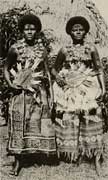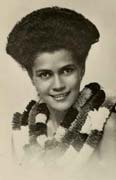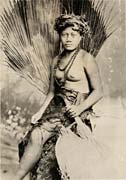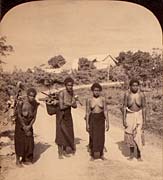These are photos in formats other than postcards. For postcards covering this period see the relevant "cards" page.
A. Small commercially released cards:
These pictures were offset printed as cards measuring 70x115mm (just a little bigger than the average playing card). The first ten are a little set, in an envelope titled "South Seas Views: Fiji Islands: Series of Ten". It was part of the estate of an American serviceman who served in Fiji in the early 1940s. However, it is safe to assume that the photographs were taken during the decade before that, and indeed at least one of the images, that of the canoes on the river (S2), pre-dates that by as much as 40 years, as probably does the "Fisher Girl" (S1) - favourite photographs were often recycled many times. The final photograph, labelled S19, is from the same series, but an odd card from a larger 20-card series that was also released. I have no others from the expanded set. There is no identification on the cards but in fact they were published by "Co-Operative", a trading name at that time of Stinson's Studios.
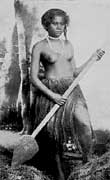 |
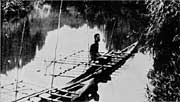 |
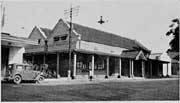 |
|
She wears tobe virgin plaits on the left side of her hair (which would be shorn by her husband on marriage), and a shell necklace. She is holding a paddle, and the photographer has inappropriately garbed her in a man's liku or war-skirt, rather than the much shorter woman's liku, or more appropriately the rather rough and ready affair worn by women for fishing (see photo). |
This picture on the Tamavua River was probably taken by G.L.Griffiths, who originally published it as a postcard about 1900. It was reproduced many times, including in the Cyclopedia of Fiji (p.165), and as this set shows, was still being used in the 1930s.
|
The GPO has been situated in the same place in Thomson Street, just near the junction with Victoria Parade, since it was first established. See map.
|
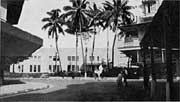 |
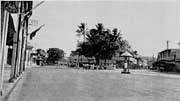 |
 |
|
This photo was taken from Renwick Road (map ref H), looking across The Triangle toward the Bank of New South Wales/Union Steamship Company building beyond. |
This photo was taken from south along Victoria Parade, looking northeast. The policeman in his little sentry-box was a feature that disappeared shortly after WW2 - there was another at "Stinson's Corner" near Burns Philp. The small oasis of The Triangle still stands in the centre of Suva, as it has since the capital was moved here in 1881. A plaque marks the spot of the first land auctions in Suva. The settlement involved the coerced removal of the indigenous people to the far less desirable area then called Suvavou, or "New Suva", beyond Lami. This settlement has spawned the notorious "sword-sellers" who harass tourists in Suva, a sort of belated revenge for their dispossession well over a century ago. |
|
 |
 |
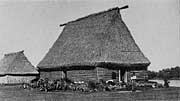 |
|
S7. "Through the Palms, Fiji" Probably along the south coast of Vitilevu between Korolevu and Korotogo, what is today known as the "Coral Coast". |
|
From the building style, perhaps in one of the villages in Nadroga Province.
|
 |
|
|
|
S10. "Native Canoes, Fiji" |
|
S19. "Sigatoka Bridge, Fiji |
B. "Real" bromide photographs in my possession
|
These two young women are dressed in ceremonial regalia such as brides would wear. They wear skirts of masi barkcloth figured in the styles of two different regions. Both wear salusalu flower necklaces, and hold ceremonial fans in their hands.The woman on the right wears a sparsely-printed white masi tutuki overskirt, the one on the left a simple cummerbund. The woman on the right finishes off her finery with a white cowry-shell necklace, taubebulileka. |
23. "Roma of Fiji"
Printed by Co-Op (Stinson Studios) in the early 1930s, but perhaps from an earlier negative. |
Non-Fijian woman wearing smoked barkcloth
This small photographic print bears no identification at all. It shows a young woman of indeterminate ethnicity (Tongan? Micronesian?) wearing a definitely Fijian smoked masi kuvui wrap-around over a cotton skirt or slip. In her left hand she holds a huge ceremonial/chief's fan. Some sort of vines or bark have been formed into a garland on her head - perhaps paper-mulberry bark. |
|
|
|
|
|
|
#12,007. FIJIAN WOMEN from the VILLAGE OF TAMAVUA, SUVA, FIJI. They are going to the Suva market with produce for sale.
Left frame of a Stereograph printed by Rose Stereographs, Melbourne, Sydney, Wellington & London. Undated and could have been taken any time during the first third of the 20th Century |
|
Link: Laurier Parham photographs of remote parts of Fiji in the 1930s

